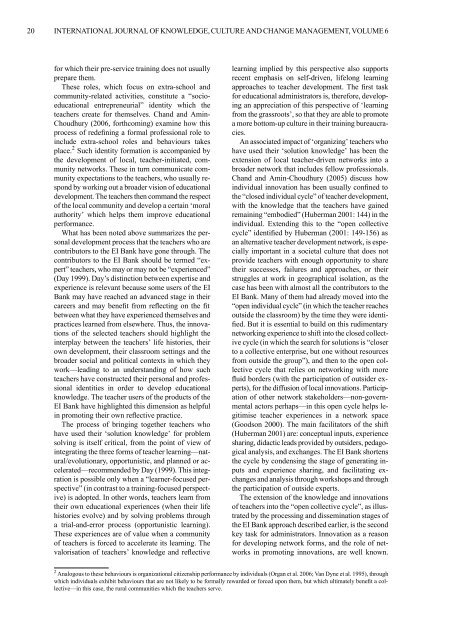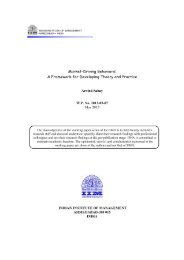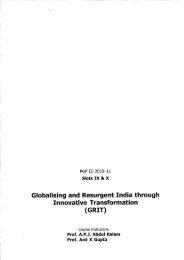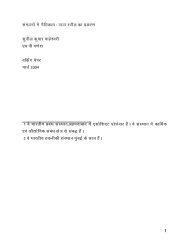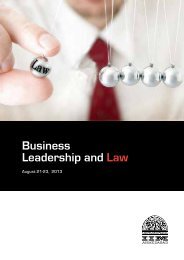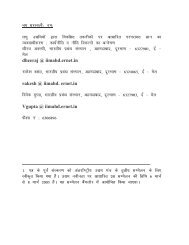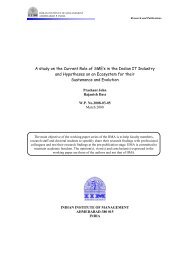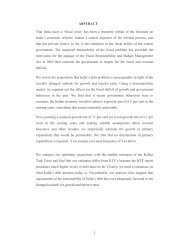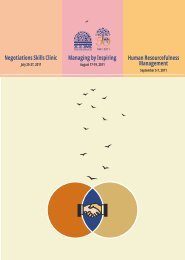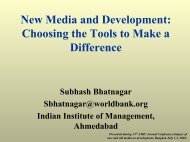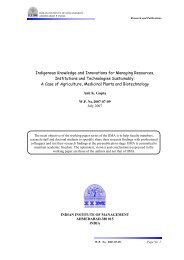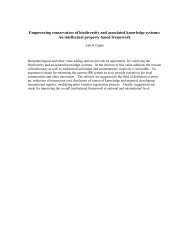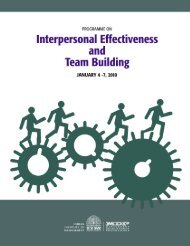related paper - Indian Institute of Management, Ahmedabad
related paper - Indian Institute of Management, Ahmedabad
related paper - Indian Institute of Management, Ahmedabad
You also want an ePaper? Increase the reach of your titles
YUMPU automatically turns print PDFs into web optimized ePapers that Google loves.
20<br />
INTERNATIONAL JOURNAL OF KNOWLEDGE, CULTURE AND CHANGE MANAGEMENT, VOLUME 6<br />
for which their pre-service training does not usually<br />
prepare them.<br />
These roles, which focus on extra-school and<br />
community-<strong>related</strong> activities, constitute a “socioeducational<br />
entrepreneurial” identity which the<br />
teachers create for themselves. Chand and Amin-<br />
Choudhury (2006, forthcoming) examine how this<br />
process <strong>of</strong> redefining a formal pr<strong>of</strong>essional role to<br />
include extra-school roles and behaviours takes<br />
place. 2 Such identity formation is accompanied by<br />
the development <strong>of</strong> local, teacher-initiated, community<br />
networks. These in turn communicate community<br />
expectations to the teachers, who usually respond<br />
by working out a broader vision <strong>of</strong> educational<br />
development. The teachers then command the respect<br />
<strong>of</strong> the local community and develop a certain ‘moral<br />
authority’ which helps them improve educational<br />
performance.<br />
What has been noted above summarizes the personal<br />
development process that the teachers who are<br />
contributors to the EI Bank have gone through. The<br />
contributors to the EI Bank should be termed “expert”<br />
teachers, who may or may not be “experienced”<br />
(Day 1999). Day’s distinction between expertise and<br />
experience is relevant because some users <strong>of</strong> the EI<br />
Bank may have reached an advanced stage in their<br />
careers and may benefit from reflecting on the fit<br />
between what they have experienced themselves and<br />
practices learned from elsewhere. Thus, the innovations<br />
<strong>of</strong> the selected teachers should highlight the<br />
interplay between the teachers’ life histories, their<br />
own development, their classroom settings and the<br />
broader social and political contexts in which they<br />
work—leading to an understanding <strong>of</strong> how such<br />
teachers have constructed their personal and pr<strong>of</strong>essional<br />
identities in order to develop educational<br />
knowledge. The teacher users <strong>of</strong> the products <strong>of</strong> the<br />
EI Bank have highlighted this dimension as helpful<br />
in promoting their own reflective practice.<br />
The process <strong>of</strong> bringing together teachers who<br />
have used their ‘solution knowledge’ for problem<br />
solving is itself critical, from the point <strong>of</strong> view <strong>of</strong><br />
integrating the three forms <strong>of</strong> teacher learning—natural/evolutionary,<br />
opportunistic, and planned or accelerated—recommended<br />
by Day (1999). This integration<br />
is possible only when a “learner-focused perspective”<br />
(in contrast to a training-focused perspective)<br />
is adopted. In other words, teachers learn from<br />
their own educational experiences (when their life<br />
histories evolve) and by solving problems through<br />
a trial-and-error process (opportunistic learning).<br />
These experiences are <strong>of</strong> value when a community<br />
<strong>of</strong> teachers is forced to accelerate its learning. The<br />
valorisation <strong>of</strong> teachers’ knowledge and reflective<br />
learning implied by this perspective also supports<br />
recent emphasis on self-driven, lifelong learning<br />
approaches to teacher development. The first task<br />
for educational administrators is, therefore, developing<br />
an appreciation <strong>of</strong> this perspective <strong>of</strong> ‘learning<br />
from the grassroots’, so that they are able to promote<br />
a more bottom-up culture in their training bureaucracies.<br />
An associated impact <strong>of</strong> ‘organizing’ teachers who<br />
have used their ‘solution knowledge’ has been the<br />
extension <strong>of</strong> local teacher-driven networks into a<br />
broader network that includes fellow pr<strong>of</strong>essionals.<br />
Chand and Amin-Choudhury (2005) discuss how<br />
individual innovation has been usually confined to<br />
the “closed individual cycle” <strong>of</strong> teacher development,<br />
with the knowledge that the teachers have gained<br />
remaining “embodied” (Huberman 2001: 144) in the<br />
individual. Extending this to the “open collective<br />
cycle” identified by Huberman (2001: 149-156) as<br />
an alternative teacher development network, is especially<br />
important in a societal culture that does not<br />
provide teachers with enough opportunity to share<br />
their successes, failures and approaches, or their<br />
struggles at work in geographical isolation, as the<br />
case has been with almost all the contributors to the<br />
EI Bank. Many <strong>of</strong> them had already moved into the<br />
“open individual cycle” (in which the teacher reaches<br />
outside the classroom) by the time they were identified.<br />
But it is essential to build on this rudimentary<br />
networking experience to shift into the closed collective<br />
cycle (in which the search for solutions is “closer<br />
to a collective enterprise, but one without resources<br />
from outside the group”), and then to the open collective<br />
cycle that relies on networking with more<br />
fluid borders (with the participation <strong>of</strong> outsider experts),<br />
for the diffusion <strong>of</strong> local innovations. Participation<br />
<strong>of</strong> other network stakeholders—non-governmental<br />
actors perhaps—in this open cycle helps legitimise<br />
teacher experiences in a network space<br />
(Goodson 2000). The main facilitators <strong>of</strong> the shift<br />
(Huberman 2001) are: conceptual inputs, experience<br />
sharing, didactic leads provided by outsiders, pedagogical<br />
analysis, and exchanges. The EI Bank shortens<br />
the cycle by condensing the stage <strong>of</strong> generating inputs<br />
and experience sharing, and facilitating exchanges<br />
and analysis through workshops and through<br />
the participation <strong>of</strong> outside experts.<br />
The extension <strong>of</strong> the knowledge and innovations<br />
<strong>of</strong> teachers into the “open collective cycle”, as illustrated<br />
by the processing and dissemination stages <strong>of</strong><br />
the EI Bank approach described earlier, is the second<br />
key task for administrators. Innovation as a reason<br />
for developing network forms, and the role <strong>of</strong> networks<br />
in promoting innovations, are well known.<br />
2 Analogous to these behaviours is organizational citizenship performance by individuals (Organ et al. 2006; Van Dyne et al. 1995), through<br />
which individuals exhibit behaviours that are not likely to be formally rewarded or forced upon them, but which ultimately benefit a collective—in<br />
this case, the rural communities which the teachers serve.


